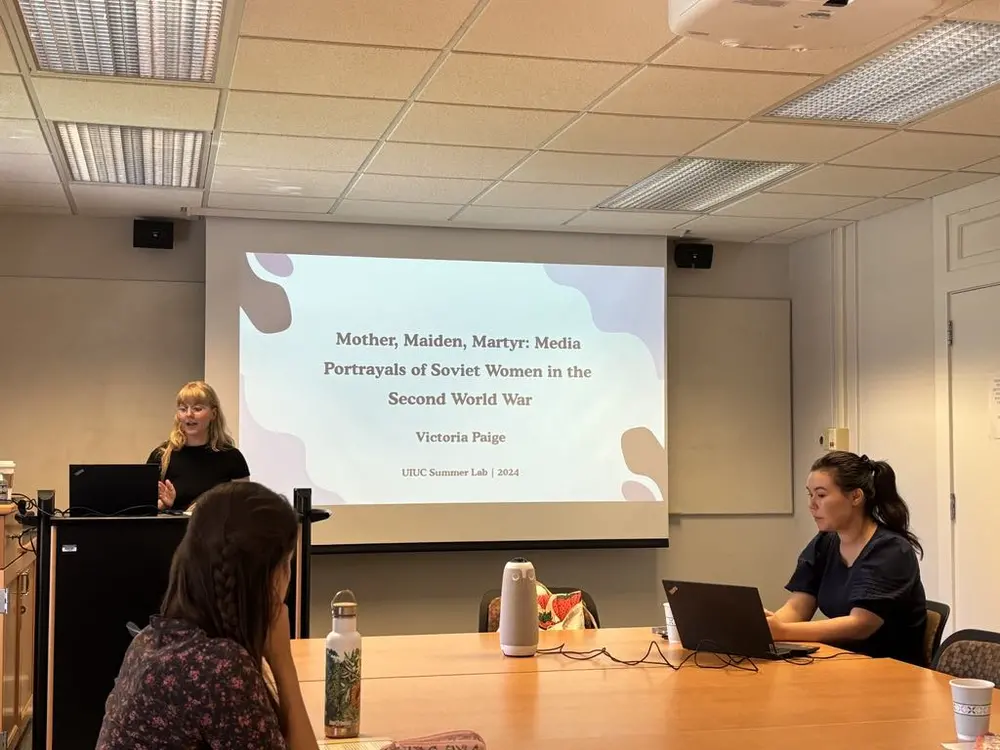
Under the auspices of the mobilization drive in the 1930s, Soviet media started actively encouraging women to participate in armed forces as civilian soldiers. As World War II raged, in April 1942 women could officially enlist in combat positions. As the war ended, the Soviet legislation prohibited women from future enlistment, the decree lasted until the breakdown of the USSR. The recipient of the 2024 Fisher Fellow Award Victoria Paige discussed the patterns of representing women on the frontline in Soviet media before, during, and after World War II in her talk “Mother, Maiden, Martyr: Media Portrayals of Soviet Women in the Second World War,” given on June 27 as part of the 2024 Summer Research Laboratory. Victoria is a PhD candidate in history at The Ohio State University. Her dissertation project examines media representations of Soviet women in war, including in film, literature, and periodicals, and how they reflect anxieties around preserving military masculinity. The Fisher Fellow Talk was an overview of her dissertation project currently in progress.
A critical starting point in Victoria’s research is the beginning of the World War II when the masculinity of Soviet soldiers that was traditionally associated with military service became jeopardized by the growing influx of female soldiers to the front. At this time, Soviet media started defending the military masculinity realm by framing women’s experience in the war as specifically female – nurses, mothers, and martyrs.
The scope of material that Victoria uses for her research is broad, including films, periodicals, and literature. In her talk Victoria points out that pre-war era films such as Chapaev (1934) and Alexander Nevsky (1938) show women-soldiers’ images that lose their integrity and become more gender-instilled through sexual assault scenes and conversations about marriage and motherhood. In poems such as How Did You Help the Front? (1942) by Demyan Bedny and in various journal articles in Pravda, Ogonek, Krestianka, and Rabotnitsa women are portrayed mainly as nurses, and their military service is perceived as irregular and temporary. The vulnerability and femininity in the images of women-martyrs are amplified in Soviet films during World War II (Rainbow, 1943, Zoya, 1944).
Drawing on conceptualizations of military masculinity and womanhood in the Soviet Union in the works of such authors as Erica L. Fraser and Anna Krylova, Victoria argues that the pre-war, war, and post-war portrayals of women in the armed forces in Soviet media indicate the anxieties around preserving military masculinity and illuminate the distinct status of women in the Stalinist gender order.
In the future, she is planning to include the analysis of male-centered narratives that would uncover different aspects of military masculinity discourse in the Soviet Union. After the talk, Victoria also received advice about incorporating media portrayal of women in other types of military services such as factory work, bomb deactivation, etc. Guests also suggested her analyzing how these descriptions differ from stories about women in combat positions and how they maintain the symbolic juxtaposition between front and тыл military services.
The Fisher Fellow Award is presented annually in honor of Dr. Ralph Fisher, the founder of REEEC, the SRL, and a champion for building the Slavic collection at the University of Illinois Library. Thanks to Fisher’s vision, the University Library and Slavic Reference Service provide a consummate collection and outstanding research support service to junior scholars around the globe. The award is generously funded in part by the U.S. Department of State’s Title VIII Program.
--
Karina Povsteva is a PhD student in the Department of Slavic Languages and Literatures, University of Illinois Urbana-Champaign, and a summer graduate assistant at REEEC. Her research is focused on pedestrian mobility and children’s street life regulation practices in the big Soviet cities in the 1920s-1930s.